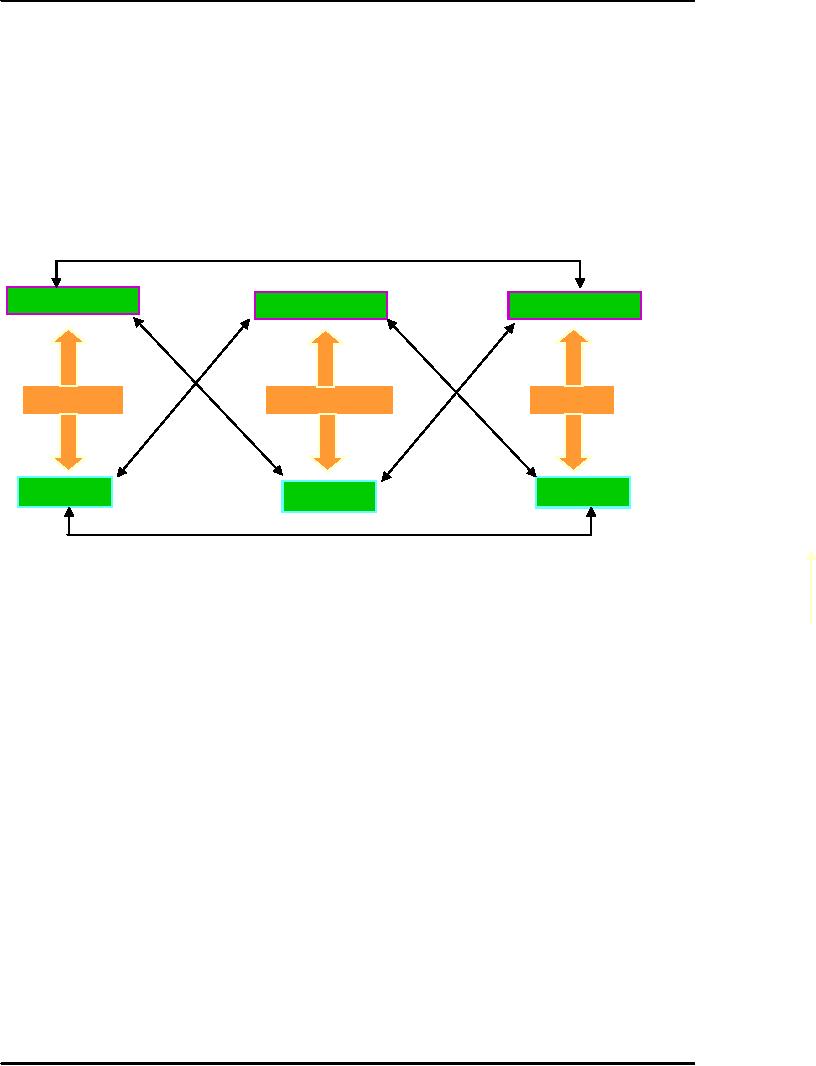 |
ETHICAL ISSUES IN RESEARCH:Ethical Treatment of Participants |
| << THE RESEARCH PROCESS:Broad Problem Area, Theoretical Framework |
| ETHICAL ISSUES IN RESEARCH (Cont):Debriefing, Rights to Privacy >> |

Research
Methods STA630
VU
Lesson
13
ETHICAL
ISSUES IN RESEARCH
Ethics
are norms or standards of
behavior that guide moral
choices about our behavior
and our
relationships
with others. The goal of
ethics in research is to ensure
that no one is harmed or suffers
adverse
consequences from research
activities. This objective is
usually achieved. However,
unethical
activities
are pervasive and include
violating nondisclosure agreements,
breaking respondent
confidentiality,
misrepresenting results, deceiving
people, invoicing irregularities,
avoiding legal
liability,
and more.
As
discussed earlier, ethical questions
are philosophical questions. There is no
general agreement
among
philosophers about the answers to
such questions. However the rights and
obligations of
individuals
are generally dictated by the
norms of society. Societal
norms are codes of
behavior
adopted
by a group; they suggest
what a member of a group
ought to do under given
circumstances.
Nevertheless,
with changing situations
people continue differing
with each other whereby
societal
norms
may undergo changes. Codes
and regulations guide researchers and
sponsors. Review
boards
and
peer groups help researchers
examine their research proposals
for ethical dilemmas. Responsible
researchers
anticipate ethical dilemmas and attempt
to adjust the design, procedures, and
protocols
during
the planning process rather than
treating them as afterthought. Ethical
research requires personal
integrity
from the researcher, the project manager,
and the research sponsor.
Codes
of ethic applicable at each stage of
the research
Goal
To
ensure that no one is harmed or suffers
adverse consequences from
research activities
Unethical
activities
·
Violating
nondisclosure agreements.
·
Breaking
respondent confidentiality.
·
Misrepresenting
results.
·
Deceiving
people.
·
Invoicing
irregularities.
·
Avoiding
legal liability.
Ethical
Issues
·
Remain
to be issues.
·
Local
norms suggest what ought to
be done under the given
circumstances.
·
Codes
of ethics developed to guide researchers
and sponsors.
·
Review
Boards and peer groups help sorting
out ethical dilemmas.
Anticipate
ethical dilemmas
·
Adjust
the design, procedures, and protocols
accordingly.
·
Research
ethics require personal integrity of the
researcher, the project manager, and
research
sponsor.
Parties
in Research
·
Mostly
three parties:
·
The
researcher
·
The
sponsoring client (user)
·
The
respondent (subject)
41

Research
Methods STA630
VU
·
Interaction
requires ethical questions.
·
Each
party expects certain rights
and feels certain
obligations.
General
Rights and Obligations of Parties
Concerned
In
most research situations, three parties
are involved: the researcher,
the
sponsoring
client (user),
and
the
respondent
(subject). The
interaction of each of these parties
with one or both of the
other two
identifies
a series of ethical questions.
Consciously or consciously, each
party expects certain rights
and
feels
certain obligations towards the other
parties.
Interaction
of rights and obligations of
parties in research
Obligations
Obligations
Obligations
Subject
Researcher
Client
Rights
Rights
Rights
Ethical
Treatment of Participants
When
ethics are discussed in
research design, we often think
first about protecting the
rights of the
participant,
respondent, or subject. Whether data are
gathered in an experiment, interview,
observation,
or
survey, the respondent has many
rights to be safeguarded. In general the research
must be designed
so
that a respondent does not
suffer physical harm, discomfort,
pain, embarrassment, or loss of
privacy.
To
safeguard against these, the researcher
should follow three
guidelines;
1.
Explain
study benefits.
2.
Explain
respondent rights and protections.
3.
Obtain
informed consent.
Benefits:
Whenever
direct contact is made with a respondent,
the researcher should discuss the
study's benefits,
being
careful to neither overstate nor
understate the benefits. An
interviewer should begin
an
introduction
with his or her name, the
name of the research organization, and a
brief description of the
purpose
and benefit of the research. This
puts the respondent at ease, lets them
know to whom they
are
speaking,
and motivates them to answer questions
truthfully. In short, knowing why one is
being asked
questions
improves cooperation through
honest disclosure of purpose. Inducements to
participate,
financial
or otherwise, should not be
disproportionate to the task or presented
in a fashion that results
in
coercion.
Sometimes
the actual purpose and
benefits of the study or experiment
must be concealed from
the
respondents
to avoid introducing bias. The
need for concealing
objectives leads directly to the
problem
of
deception.
42
Table of Contents:
- INTRODUCTION, DEFINITION & VALUE OF RESEARCH
- SCIENTIFIC METHOD OF RESEARCH & ITS SPECIAL FEATURES
- CLASSIFICATION OF RESEARCH:Goals of Exploratory Research
- THEORY AND RESEARCH:Concepts, Propositions, Role of Theory
- CONCEPTS:Concepts are an Abstraction of Reality, Sources of Concepts
- VARIABLES AND TYPES OF VARIABLES:Moderating Variables
- HYPOTHESIS TESTING & CHARACTERISTICS:Correlational hypotheses
- REVIEW OF LITERATURE:Where to find the Research Literature
- CONDUCTING A SYSTEMATIC LITERATURE REVIEW:Write the Review
- THEORETICAL FRAMEWORK:Make an inventory of variables
- PROBLEM DEFINITION AND RESEARCH PROPOSAL:Problem Definition
- THE RESEARCH PROCESS:Broad Problem Area, Theoretical Framework
- ETHICAL ISSUES IN RESEARCH:Ethical Treatment of Participants
- ETHICAL ISSUES IN RESEARCH (Cont):Debriefing, Rights to Privacy
- MEASUREMENT OF CONCEPTS:Conceptualization
- MEASUREMENT OF CONCEPTS (CONTINUED):Operationalization
- MEASUREMENT OF CONCEPTS (CONTINUED):Scales and Indexes
- CRITERIA FOR GOOD MEASUREMENT:Convergent Validity
- RESEARCH DESIGN:Purpose of the Study, Steps in Conducting a Survey
- SURVEY RESEARCH:CHOOSING A COMMUNICATION MEDIA
- INTERCEPT INTERVIEWS IN MALLS AND OTHER HIGH-TRAFFIC AREAS
- SELF ADMINISTERED QUESTIONNAIRES (CONTINUED):Interesting Questions
- TOOLS FOR DATA COLLECTION:Guidelines for Questionnaire Design
- PILOT TESTING OF THE QUESTIONNAIRE:Discovering errors in the instrument
- INTERVIEWING:The Role of the Interviewer, Terminating the Interview
- SAMPLE AND SAMPLING TERMINOLOGY:Saves Cost, Labor, and Time
- PROBABILITY AND NON-PROBABILITY SAMPLING:Convenience Sampling
- TYPES OF PROBABILITY SAMPLING:Systematic Random Sample
- DATA ANALYSIS:Information, Editing, Editing for Consistency
- DATA TRANSFROMATION:Indexes and Scales, Scoring and Score Index
- DATA PRESENTATION:Bivariate Tables, Constructing Percentage Tables
- THE PARTS OF THE TABLE:Reading a percentage Table
- EXPERIMENTAL RESEARCH:The Language of Experiments
- EXPERIMENTAL RESEARCH (Cont.):True Experimental Designs
- EXPERIMENTAL RESEARCH (Cont.):Validity in Experiments
- NON-REACTIVE RESEARCH:Recording and Documentation
- USE OF SECONDARY DATA:Advantages, Disadvantages, Secondary Survey Data
- OBSERVATION STUDIES/FIELD RESEARCH:Logic of Field Research
- OBSERVATION STUDIES (Contd.):Ethical Dilemmas of Field research
- HISTORICAL COMPARATIVE RESEARCH:Similarities to Field Research
- HISTORICAL-COMPARATIVE RESEARCH (Contd.):Locating Evidence
- FOCUS GROUP DISCUSSION:The Purpose of FGD, Formal Focus Groups
- FOCUS GROUP DISCUSSION (Contd.):Uses of Focus Group Discussions
- REPORT WRITING:Conclusions and recommendations, Appended Parts
- REFERENCING:Book by a single author, Edited book, Doctoral Dissertation